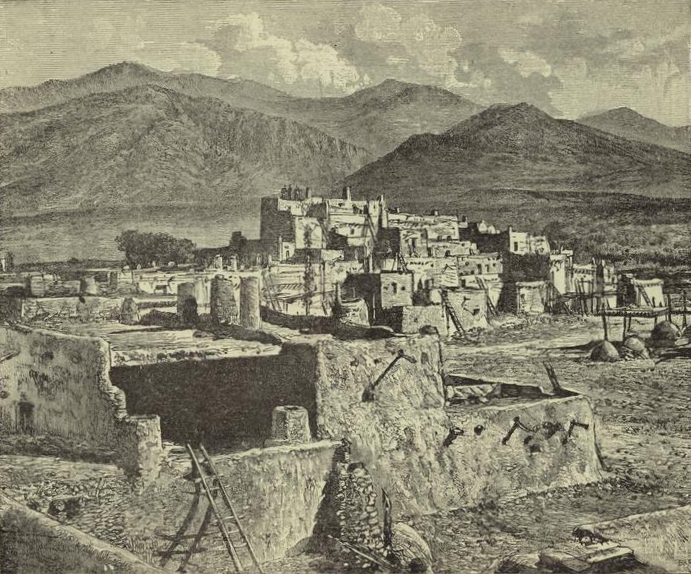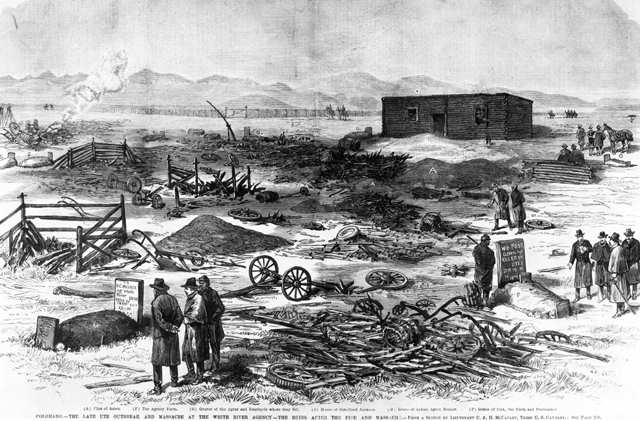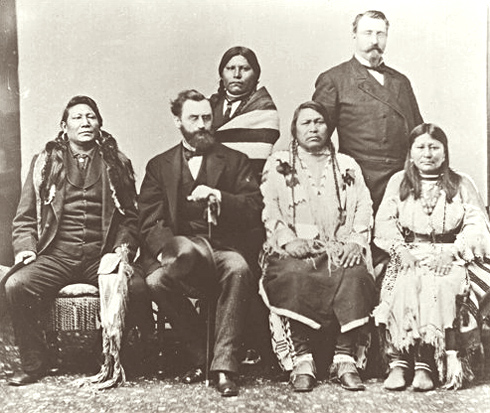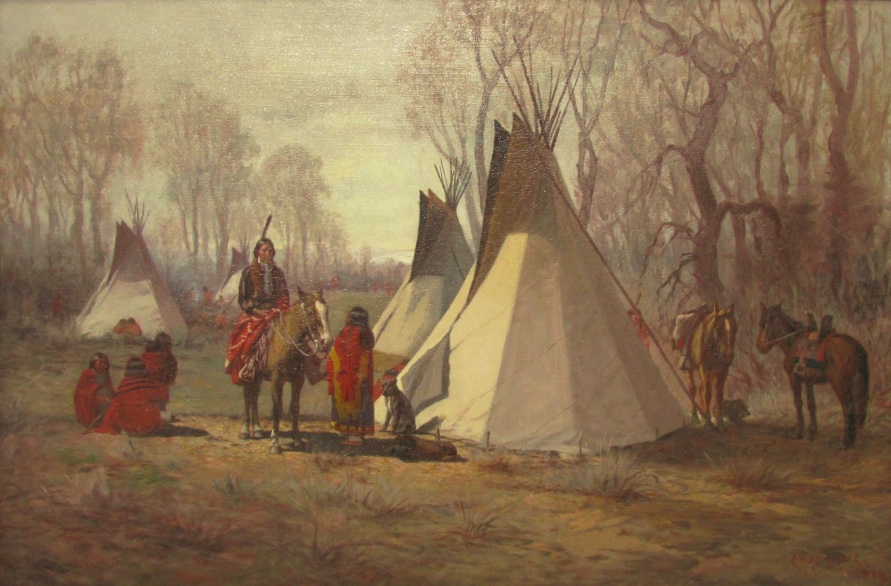|
Chipeta
Chipeta or White Singing Bird (1843 or 1844 – August 9, 1924) was a Native American leader, and the second wife of Chief Ouray of the Uncompahgre Ute tribe. Born a Kiowa Apache, she was raised by the Utes in what is now Conejos, Colorado. An advisor and confidant of her husband, Chipeta continued as a leader of her people after his death in 1880. She was an Indian rights advocate and diplomat. She used diplomacy to try to achieve peace with the white settlers in Colorado. In 1985, Chipeta was inducted into Colorado Women's Hall of Fame for her "courage and valor she demonstrated in her efforts to mediate between Native Americans and whites." Personal life Chipeta, also known as "White Singing Bird", was born into the Kiowa Apache tribe in about 1843. She was adopted and raised by the Uncompahgre Utes in what is now Conejos, Colorado. She learned their traditional ways and became a skilled artisan in beadwork, tanning and making garments, like dresses, shirts, moccasins, ... [...More Info...] [...Related Items...] OR: [Wikipedia] [Google] [Baidu] |
Ouray (Ute Leader)
Ouray (, c. 1833 – August 20, 1880) was a Native American chief of the Tabeguache (Uncompahgre) band of the Ute tribe, then located in western Colorado. Because of his leadership ability, Ouray was acknowledged by the United States government as a chief of the Ute and he traveled to Washington, D.C. to negotiate for the welfare of the Utes. Raised in the culturally diverse town of Taos, Ouray learned to speak many languages that helped him in the negotiations, which were complicated by the manipulation of his grief over his five-year-old son, abducted during an attack by the Sioux. Ouray met with Presidents Lincoln, Grant, and Hayes and was called the "man of peace" because he sought to make treaties with settlers and the government. Following the Meeker Massacre (White River War) of 1879, he traveled in 1880 to Washington, D.C. He tried to secure a treaty for the Uncompahgre Ute, who wanted to stay in Colorado; but, the following year, the United States forced the Uncompahgr ... [...More Info...] [...Related Items...] OR: [Wikipedia] [Google] [Baidu] |
Colorado Women's Hall Of Fame
The Colorado Women's Hall of Fame is a non-profit, volunteer organization that recognizes women who have contributed to the history of the U.S. state of Colorado Colorado is a U.S. state, state in the Western United States. It is one of the Mountain states, sharing the Four Corners region with Arizona, New Mexico, and Utah. It is also bordered by Wyoming to the north, Nebraska to the northeast, Kansas .... As of 2024, 205 women have been inducted. History There was a short-lived recognition program established in Colorado in 1965 to honor the contributions of women to the state, known as the Colorado Women of Achievement awards. Each year, three honorees from throughout the state who had distinguished themselves in their profession or avocation were recognized at an annual banquet held in Denver, given a cash award, and received a pin with the emblem of the program, which was sponsored by the Columbia Savings and Loan Association. The 1965 inductees, honored in 1966, includ ... [...More Info...] [...Related Items...] OR: [Wikipedia] [Google] [Baidu] |
Ute People
Ute () are an Indigenous peoples of the Great Basin, Indigenous people of the Great Basin and Colorado Plateau in present-day Utah, western Colorado, and northern New Mexico.Pritkzer''A Native American Encyclopedia'' p. 242 Historically, their territory also included parts of Wyoming, eastern Nevada, and Arizona. Their Ute dialect is a Colorado River Numic language, part of the Uto-Aztecan language family Historically, the Utes belonged to almost a dozen nomadic bands, who came together for ceremonies and trade. They also traded with neighboring tribes, including Pueblo peoples. The Ute had settled in the Four Corners region by 1500 CE. The Utes' first contact with Europeans was with the Spanish in the 18th century. The Utes had already acquired horses from neighboring tribes by the late 17th century. They had limited direct contact with the Spanish but participated in regional trade. Sustained contact with Euro-Americans began in 1847 with the arrival of the Mormons to the Am ... [...More Info...] [...Related Items...] OR: [Wikipedia] [Google] [Baidu] |
Josephine Meeker
Josephine Meeker (January 28, 1857 – December 20, 1882), was a teacher and physician at the White River Indian Agency in Colorado Territory, where her father Nathan Meeker was the United States (US) agent. On September 29, 1879, he and 10 of his male employees were killed in a Ute attack, in what became known as the Meeker Massacre. Josephine, her mother Arvilla Meeker, and Mrs. Shadruck Price and her two children were taken captive and held hostage by the Ute tribe for 23 days. Following the rescue of the hostages, Meeker recounted her experiences at a public hearing. General Charles Adams, of the Colorado Militia that arranged the captives' release, conducted an official investigation of the incident. Josephine Meeker's testimony provides keen insight into the experiences a white woman underwent as an Indian captive. She was the last celebrated white captive of Native Americans.Brown, p.11 Working for some time in Washington, D.C., and then for Senator Henry Moore Telle ... [...More Info...] [...Related Items...] OR: [Wikipedia] [Google] [Baidu] |
White River War
Meeker Massacre, or Meeker Incident, White River War, Ute War, or the Ute Campaign), took place on September 29, 1879 in Colorado. Members of a band of Ute Indians ( Native Americans) attacked the Indian agency on their reservation, killing the Indian agent Nathan Meeker and his 10 male employees and taking five women and children as hostages. Meeker had been attempting to convert the Utes to Christianity, to make them farmers, and to prevent them from following their nomadic culture. On the same day as the massacre, United States Army forces were en route to the Agency from Fort Steele in Wyoming due to threats against Meeker. The Utes attacked U.S. troops led by Major Thomas T. Thornburgh at Milk Creek, north of present day Meeker, Colorado. They killed the major and 13 troops. Relief troops were called in and the Utes dispersed. The conflict resulted in the Utes losing most of the lands granted to them by treaty in Colorado, the forced removal of the White River Utes an ... [...More Info...] [...Related Items...] OR: [Wikipedia] [Google] [Baidu] |
Meeker Massacre
Meeker Massacre, or Meeker Incident, White River War, Ute War, or the Ute Campaign), took place on September 29, 1879 in Colorado. Members of a band of Ute people, Ute Indians (Native Americans of the United States, Native Americans) attacked the Indian agency on their reservation, killing the Indian agent Nathan Meeker and his 10 male employees and taking five women and children as hostages. Meeker had been attempting to convert the Utes to Christianity, to make them farmers, and to prevent them from following their nomadic culture. On the same day as the massacre, United States Army forces were en route to the Agency from Fort Steele (Wyoming), Fort Steele in Wyoming due to threats against Meeker. The Utes attacked U.S. troops led by Major (rank), Major Thomas T. Thornburgh at Milk Creek, north of present day Meeker, Colorado. They killed the major and 13 troops. Relief troops were called in and the Utes dispersed. The conflict resulted in the Utes losing most of the lands ... [...More Info...] [...Related Items...] OR: [Wikipedia] [Google] [Baidu] |
Milk Creek Battle
Meeker Massacre, or Meeker Incident, White River War, Ute War, or the Ute Campaign), took place on September 29, 1879 in Colorado. Members of a band of Ute Indians ( Native Americans) attacked the Indian agency on their reservation, killing the Indian agent Nathan Meeker and his 10 male employees and taking five women and children as hostages. Meeker had been attempting to convert the Utes to Christianity, to make them farmers, and to prevent them from following their nomadic culture. On the same day as the massacre, United States Army forces were en route to the Agency from Fort Steele in Wyoming due to threats against Meeker. The Utes attacked U.S. troops led by Major Thomas T. Thornburgh at Milk Creek, north of present day Meeker, Colorado. They killed the major and 13 troops. Relief troops were called in and the Utes dispersed. The conflict resulted in the Utes losing most of the lands granted to them by treaty in Colorado, the forced removal of the White River Utes an ... [...More Info...] [...Related Items...] OR: [Wikipedia] [Google] [Baidu] |
Charles Adams (Colorado Indian Agent)
Charles Adams, born Karl Adam Schwanbeck (December 19, 1845 – August 19, 1895), was a United States Army officer, US Indian agent, diplomat and businessman. In 1879 he secured the release of five hostages taken captive by the White River Utes after the Meeker Massacre, and held an official inquiry into their treatment. In 1880 he was appointed minister to Bolivia, where he served for two years. Returning to Colorado, he became involved in mining and water development. Early life and education Born in Anklam, Province of Pomerania, Kingdom of Prussia in 1845, Charles was the son of cabinetmaker Karl Heinrich and Maria J. Mackman Schwanbeck. His family immigrated to the United States after the Revolutions of 1848 in Germany. Career Schwanbeck fought as a young man in the late years of the American Civil War. After the war he migrated to the Colorado Territory. About 1870, he was appointed a brigadier general of the Colorado Militia, by when he had changed his surname to ... [...More Info...] [...Related Items...] OR: [Wikipedia] [Google] [Baidu] |
Uncompahgre Ute
The Uncompahgre Ute () or ꞌAkaꞌ-páa-gharʉrʉ Núuchi (also: Ahkawa Pahgaha Nooch) is a band of the Ute people, Ute, a Native American tribe located in the US states of Colorado and Utah. In the Ute language, means "rocks that make water red." The band was formerly called the Tabeguache. Tabeguache The Tabeguache (Ute dialect, Ute language: , ,, and ), or “People of Sun Mountain,” was the largest of the ten nomadic bands of the Ute and part of the Northern Ute People. They lived in river valleys of the Gunnison River and Uncompahgre River between the Parianuche to the north and the Weeminuche to the south. They traveled seasonally. Like other Ute, they were hunters who followed and hunted buffalo, deer, and elk. They moved their camp about every month, and created a link to Mother Earth at each camp by constructing a medicine wheel at the center of camp. The Tabeguache believed that the Pikes Peak, Pikes Peak region is their home. Their name for the mountain is , mea ... [...More Info...] [...Related Items...] OR: [Wikipedia] [Google] [Baidu] |
Fort Fred Steele State Historic Site
Fort Steele, also known as Fort Fred Steele, was established to protect the newly built Union Pacific Railroad from attacks by Native Americans during construction of the transcontinental railroad in the United States. The fort was built in 1868 where the railroad crossed the North Platte River in Carbon County, Wyoming. Work on the fort was carried out by military and civilian labor. Fort Steele was one of three forts built on the line. Fort Sanders (originally Fort John Buford) near Laramie and Fort D.A. Russell at Cheyenne were the other railroad forts. Fort Steele was named for the recently deceased General Frederick Steele. History Immediately after the fort's establishment in the summer of 1868 it was the scene of a meeting that included Generals Ulysses S. Grant and William Tecumseh Sherman, who had come west to inspect the railroad, accompanied by Generals Philip Sheridan, August Kautz, Joseph H. Potter, William S. Harney, Frederick T. Dent and Adam J. Slemm ... [...More Info...] [...Related Items...] OR: [Wikipedia] [Google] [Baidu] |
Indian Agent
In United States history, an Indian agent was an individual authorized to interact with American Indian tribes on behalf of the U.S. government. Agents established in Nonintercourse Act of 1793 The federal regulation of Indian affairs in the United States first included development of the position of Indian agent in the Nonintercourse Act of 1793, a revision of the original 1790 law. This required land sales by or from Indians to be federally licensed and permitted. The legislation also authorized the President to "appoint such persons, from time to time, as temporary agents to reside among the Indians," and guide them into acculturation of American society by changing their agricultural practices and domestic activities. Eventually, the U.S. government ceased using the word "temporary" in the Indian agent's job title. Changing role of Indian Agents, 1800–1840s From the close of the 18th century to nearly 1869, Congress maintained the position that it was legally responsible ... [...More Info...] [...Related Items...] OR: [Wikipedia] [Google] [Baidu] |







